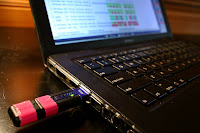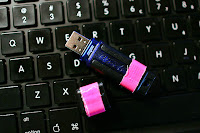Backing Data Up On The Road 101 : Part 1
Web: www.thetravelstrategist.com — E-Mail: fish@flyingwithfish.com
12/11/2008 – Backing Data Up On The Road 101 : Part 1
Working on the road has many challenges. One challenge is backing up your critical data as it is produced. When on the road the unexpected can happen and sometimes the unexpected can be devastating to your work and your data.
When on the road I generally employ two different back-ups to my work daily (or when the opportunity presents its self). In this entry of “Backing Up On the Road 101†I am only going to discuss the simplest, least expensive and most secure way to ensure your data survives disaster.
What is this “magic solution?” Simple, it is using solid-state USB Flash Drives. The capacity of the USB Flash Drives is increasing while the prices have been steadily dropping over the last few years. With 16gb USB Flash Drives now readily available for under US$50.00, and 32gb USB Flash Drives coming in at under US$100.00, backing up critical data on the road is pocket sized and cost effective.
So what makes USB Flash Drives ideal for secure data backup?
For starters the drive is sold-state. Unlike your laptop (well most laptops) and external hard drive, a USB Flash Drive has no moving parts. By using solid-state memory if your flash drives suffers an impact, there is a very minimal chance you’ll lose any data. It is actually difficult to break most USB Flash-Drives through normal use (and even dropping them from two floors up while bored at 2:00am in an airport to see if the USB Flash-Drive can survive the impact).
USB Flash-Drives are sub-pocket sized. These drives are often called ‘thumb drives’ because they are about the same size an adult’s thumb. When packing it is very easy to toss half-a-dozen USB Flash Drives in your bag without taking up any space. I toss mine in a small pouch that carries my CF Card reader, USB cords and some other travel-technology basics.
Since USB Flash-Drives are solid-state, and have no moving parts, they require no external power. When you want to transfer your data you can do it anywhere. You just plug the Flash-Drive in and transfer your data. As an added bonus, USB Flash-Drives also requires very little power from your computer to power them. This makes life easy when working in an area with limited electrical outlet access.
The real security of storing data in a USB Flash-Drive is noticed when working in potentially adverse conditions that involve equipment getting wet, such as sitting at the bar in the airport (I don’t drink, but I do like buffalo wings & salad, which can usually be found at any airport bar)……..or covering a hurricane. It is nice to know that it is virtually impossible to drown a USB Flash-Drive. I have accidentally dropped a USB Flash-Drive into water and fun my Compact Flash Cards through the washer and never lost any data. Should your hard drive get drenched, chances are you killed your hard drive. Should you get your USB Flash-Drive wet, you simply (carefully) dry it out. Once dried out, you insert it into the USB port and recover your data.
There is a downside to USB Flash-Drives. USB Flash-Drives are much slower than mechanical hard drives. You will experience this speed difference when uploading and downloading data. While the speed difference is significant, the positives significantly outweigh the negatives, and the security of using a USB Flash-Drive is ideal on the road.
Below is a photo of one of my USB Flash-Drives working with my Apple 13″ MacBook



